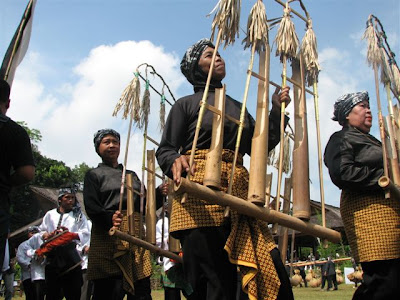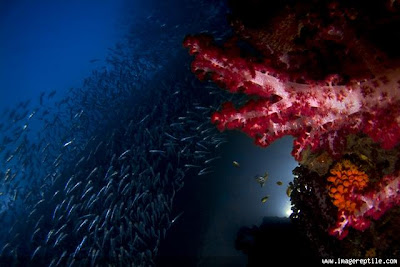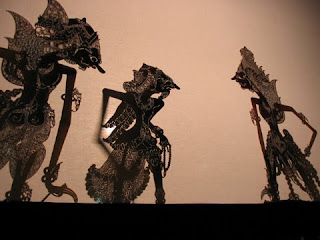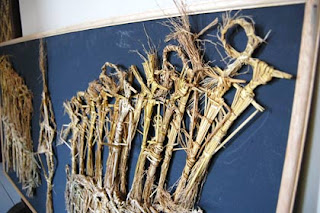
Angklung is a traditional musical instrument from West Java, made of bamboo, which sounded shaken by (the sound caused by the clash of bodies bamboo pipes) so as to produce a sound that vibrates in the arrangement of tones 2, 3, and 4 tones in every size, large and small. Barrel (tone) musical instrument Angklung as Sundanese traditional music is mostly salendro and pelog.
 The origin of Angklung
The origin of AngklungIn a clump of art that uses musical instruments from bamboo known type of art called the Angklung. The type of bamboo used as a musical instrument is the AWI wulung (black bamboo) and AWI friends (white bamboo). Purwa fine musical instrument Angklung; each tone (barrel) is produced from the sound of bamboo-shaped tube wilahan (bars) of each segment of bamboo from small to large.
Angklung is a musical instrument from West Java. Angklung gubrag in Jasinga, Bogor, is one that is still alive after more than 400 years ago. Appearance originated from rice rites. Angklung created and played to lure Dewi Sri down to Earth for the people of the rice plant thrives.

Known by the Sundanese community since the time of the Sunda kingdom, of which as penggugah spirit in battle. Angklung function as pumping continues to feel the spirit of the people still come to the colonial period, that's why the Dutch East Indies government had banned the use angklung, the ban could make angklung popularity declined and only played by children at that time.
The origin of the creation of bamboo music, such as angklung based view of the agrarian life of Sundanese people with a source of life of paddy (pare) as a staple food. This gave rise to the myth of trust in Nyai Sri Pohaci as a symbol of Goddess of Rice giver of life (breathe-Hurip).

Reflection of Sundanese people formerly in agricultural processing (tatanen) especially in the fields and shifting cultivation has spawned the creation of poetry and song as a tribute and offerings to Sri Pohaci Nyai, and the efforts nyinglar (starting reinforcements) for suitable planting them not to invite catastrophe, both pests and disasters Other natural. Buhun song lyric in honor of Sri Pohaci Nyi, for example:
Furthermore, the songs offerings to Dewi Sri is accompanied by the sound of percussion accompaniment made from bamboo poles that simple packed structures which then was born the bamboo musical instrument we know today named angklung. Subsequent developments in the game Angklung tradition accompanied by elements of motion and Ibing (dance) that rhythmic (air-wirahma) with patterns and rules = rules in accordance with the needs of the memorial on time paraded rice paddy to the barn (ngampih pare, nginebkeun), also at times mitembeyan, began planting rice in some places in West Java called ngaseuk.
Similarly, when the harvest festival dedicated to the game and seren taun angklung. Especially at the presentation ceremony Angklung related to rice, it becomes a performance art that are the parade or helaran, even in some places into the convoy Rengkong and Dongdang and Jampana (stretcher food) and so forth.
In its development, angklung grow and spread all over Java, then to Kalimantan and Sumatra. In 1908 recorded a cultural mission from Indonesia to Thailand, among others, marked the transfer angklung and bamboo music of this game also had spread there.
In fact, since 1966, Udjo Ngalagena angklung figures who developed the technique based on barrel-barrel game pelog, salendro, and madenda-start teaching how to play angklung to many people from various communities.
 Angklung Kanekes
Angklung KanekesAngklung Kanekes area (we often call them Baduy) is used primarily because of its relationship with the rites of rice, not solely for the entertainment of people. Angklung is used or is sounded when they grow rice in shifting cultivation (field). Angklung beat when growing rice there is only rung free (dikurulungkeun), especially in Kajeroan (Tangtu; Baduy Jero), and there are with certain rhythmic, namely in Kaluaran (Outer Baduy). However, still can be displayed on the outside but still have the rite paddy rules, for example, may only beaten until his ngubaran pare (treating paddy), about three months from the time of rice planted. After that, during the next six months all the arts should not be played, and can be played again on the next rice planting season. Closes angklung implemented with event called musungkeun angklung, namely nitipkeun (leave, keep) angklung after use.
In the presentation of entertainment, usually held during Angklung bright moon and no rain. They play in the game angklung (page widespread in rural areas) while singing various songs, among others: monkey Kasarung, Yandu Aunt, Yandu Sala, Ceuk Arileu, Oray-orayan, Dengdang, Yari Gandang, Oyong-Oyong Bangkong, Kula Agency, Kokoloyoran, Swing-swing, Pileuleuyan, Gandrung Mangosteen, Rujak Gadung, Mulung Muncang, Giler, Ngaranggeong, Aceukna, Marengo, Salak Sadapur, Rangda Ngendong, Celementre, Keupat Reundang, Papacangan, and Culadi Dengdang. The drummers angklung eight people and three drummers drum small size make the standing position while walking in a circle formation. Meanwhile others had ngalage (dance) with a specific movement that has been raw but simple. Everything is done only by men. This is different to the community Daduy In, they are limited by custom with the various rules pamali (abstinence; taboo), should not be doing things excessive worldly pleasures. Art solely for ritual purposes.
Angklung names in Kanekes of the largest are: ovarian, ringkung, Dongdong, gossip, engklok, ovarian leutik, torolok, and Roel. Roel which consists of 2 pieces held by a angklung. The names of the longest drum are: drum, talingtit, and percussion. The use of drum instruments there is a difference, namely in the villages they wear Kaluaran drum as much as 3 pieces. In Kajeroan; Cikeusik village, just use the drum and talingtit, without percussion. In Kajeroan, Cibeo village, just use the drum, without talingtit and percussion.
In Kanekes who is the person entitled to make angklung Kajeroan (Tangtu; Baduy Jero). Kajeroan consists of 3 villages, namely Cibeo, Cikartawana, and Cikeusik. In all three villages is not everyone can make it, only that have offspring and have the right to do just that in addition to the requirements of ritual. Angklung makers in the famous Cikeusik is Amir's father (59), and in Cikartawana father Tarnah. People buy from people Kajeroan Kaluaran in three village.
 Angklung Dogdog Lojor
Angklung Dogdog LojorArt is available at the community dogdog lojor Kasepuhan Pancer Pangawinan or customs union Banten Kidul scattered around Mount Mist (bordering Jakarta, Bogor and Lebak). Although this art is called dogdog lojor, the name of one of the instruments in it, but there is also used angklung because the connection with the ritual of rice. Once a year, after harvesting the whole community held an event or seren Serah Taun Taun on traditional village center. Traditional village center as a place of residence kokolot (elders) the place always on the move as directed supernatural.
The tradition of respect for rice in this community is still carried out because they included people who still adhere to old customs. By tradition they claim to be descendants of the officers and soldiers in the palace Pajajaran Baresan Pangawinan (soldier armed with a lance). Kasepuhan community has embraced Islam and somewhat open to the influence of modernization, as well as entertainment things worldly pleasures can be enjoyed. This attitude also affects the function of art in terms that since about the 1970s, dogdog lojor has been progressing, which is used to enliven the circumcision of children, marriage, and other festive events. The instruments used in the arts dogdog lojor is 2 pieces of fruit and 4 dogdog lojor big angklung. These four fruit angklung has a name, which is called the bark, then panembal, Kingking, and inclok. Each instrument is played by one, making a total of six people.
Songs include dogdog lojor Bale Agung, Side Hideung, shaky-shaky Papanganten, Si Tunggul Kawung, Adulilang, and Adu-complaint. These songs form of vocals with rhythmic dogdog and angklung tend to remain.
 Angklung gubrag
Angklung gubragAngklung gubrag Cipining there in the village, Cigudeg subdistrict, Bogor. Angklung has old age and used to honor the goddess of rice in the activities carry pare (rice), ngunjal pare (transporting rice), and ngadiukeun (put) into leuit (barn).
In the myth angklung gubrag began there was a time when village Cipining experiencing a bad season.
 Angklung Badeng
Angklung BadengBadeng is a type of art that emphasize the musical aspect with angklung as the main instrument. Sanding there Badeng Village, District Malangbong, Garut. Used to serve as entertainment for the benefit of the Islamic da'wah. But the alleged Badeng has been used since the old society from the pre-Islamic for events associated with the ritual of planting rice. As an art to preaching trusted Badeng developed since Islam spread in this area around the 16th century or 17. At that time the population Sanding, Arpaen and Nursaen, studied Islamic religion to the kingdom of Demak. After returning from Demak they preach spread the religion of Islam. One of the means of spreading Islam with the arts used was Badeng.
Angklung used as many as nine pieces, which is 2 angklung Roel, 1 angklung intelligence, 4 Angklung Angklung ovarian and father, 2 angklung children; 2 pieces dogdog, 2 fruit fly or gembyung, and 1 kecrek. The text uses the Sundanese language mixed with Arabic. In its development is now also used the Indonesian language. The contents of the text contains Islamic values and good advice, and according to the purposes of the event. In addition to presenting performances of the songs, well presented attraction supernatural powers, such as slicing the body with sharp weapons.
Songs Badeng: Lailahaileloh, Ya'ti, Kasreng, Yautike, Lilimbungan, Solaloh.













































 Angklung is a traditional musical instrument from West Java, made of bamboo, which sounded shaken by (the sound caused by the clash of bodies bamboo pipes) so as to produce a sound that vibrates in the arrangement of tones 2, 3, and 4 tones in every size, large and small. Barrel (tone) musical instrument Angklung as Sundanese traditional music is mostly salendro and pelog.
Angklung is a traditional musical instrument from West Java, made of bamboo, which sounded shaken by (the sound caused by the clash of bodies bamboo pipes) so as to produce a sound that vibrates in the arrangement of tones 2, 3, and 4 tones in every size, large and small. Barrel (tone) musical instrument Angklung as Sundanese traditional music is mostly salendro and pelog. Known by the Sundanese community since the time of the Sunda kingdom, of which as penggugah spirit in battle. Angklung function as pumping continues to feel the spirit of the people still come to the colonial period, that's why the Dutch East Indies government had banned the use angklung, the ban could make angklung popularity declined and only played by children at that time.
Known by the Sundanese community since the time of the Sunda kingdom, of which as penggugah spirit in battle. Angklung function as pumping continues to feel the spirit of the people still come to the colonial period, that's why the Dutch East Indies government had banned the use angklung, the ban could make angklung popularity declined and only played by children at that time. Reflection of Sundanese people formerly in agricultural processing (tatanen) especially in the fields and shifting cultivation has spawned the creation of poetry and song as a tribute and offerings to Sri Pohaci Nyai, and the efforts nyinglar (starting reinforcements) for suitable planting them not to invite catastrophe, both pests and disasters Other natural. Buhun song lyric in honor of Sri Pohaci Nyi, for example:
Reflection of Sundanese people formerly in agricultural processing (tatanen) especially in the fields and shifting cultivation has spawned the creation of poetry and song as a tribute and offerings to Sri Pohaci Nyai, and the efforts nyinglar (starting reinforcements) for suitable planting them not to invite catastrophe, both pests and disasters Other natural. Buhun song lyric in honor of Sri Pohaci Nyi, for example:

 Komodo Island is an island located in the Nusa Tenggara Islands. Komodo Island is known as a habitat for native animals dragons. This island is also the Komodo National Park which is managed by the Central Government. Komodo Island in the eastern island of Sumbawa, which are separated by the Sape Strait.
Komodo Island is an island located in the Nusa Tenggara Islands. Komodo Island is known as a habitat for native animals dragons. This island is also the Komodo National Park which is managed by the Central Government. Komodo Island in the eastern island of Sumbawa, which are separated by the Sape Strait. Administratively, this island including the District of Komodo, West Manggarai regency, East Nusa Tenggara Province, Indonesia. Komodo Island is the most western tip of Nusa Tenggara Timur province, bordering the province of West Nusa Tenggara.
Administratively, this island including the District of Komodo, West Manggarai regency, East Nusa Tenggara Province, Indonesia. Komodo Island is the most western tip of Nusa Tenggara Timur province, bordering the province of West Nusa Tenggara. On the island of Komodo dragons animals live and breed well. Until August 2009, on this island there are about 1,300 dragons tail. Coupled with other islands, such as Island and Rinca and Gili Motang, their numbers totaled about 2500 tails. There are also approximately 100 individuals dragons in Wae Wuul Nature Reserve on the mainland island of Flores, but not including the Komodo National Park.
On the island of Komodo dragons animals live and breed well. Until August 2009, on this island there are about 1,300 dragons tail. Coupled with other islands, such as Island and Rinca and Gili Motang, their numbers totaled about 2500 tails. There are also approximately 100 individuals dragons in Wae Wuul Nature Reserve on the mainland island of Flores, but not including the Komodo National Park. Besides Komodo, the island is also store a variety of exotic flora Sepang timber which by local people used as medicine and dye clothes, this nitak tree or sterculia oblongata in the believe is useful as medicines and seeds are tasty and delicious like peas.
Besides Komodo, the island is also store a variety of exotic flora Sepang timber which by local people used as medicine and dye clothes, this nitak tree or sterculia oblongata in the believe is useful as medicines and seeds are tasty and delicious like peas. History
History